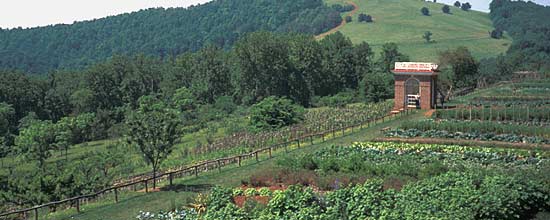

Guidelines for Reconstructing Cultural Landscapes
The Approach

Introduction
Whereas the treatment Restoration provides guidance on restoring--or re-creating--cultural landscape features, the Standards for Reconstruction and Guidelines for Reconstructing Cultural Landscapes address those aspects of treatment necessary to re-create an entire non-surviving landscape with new material. Much like restoration, the goal is to make the landscape appear as it did at a particular--and most significant--time in history. The difference is that in Reconstruction, there is far less (if any) extant historic material prior to treatment and, in some cases, there may be nothing visible. Because of the potential for historical error in the absence of sound physical evidence, this treatment can be justified only rarely and, thus, is the least frequently undertaken treatment.
For this reason, the various steps to be undertaken in Reconstruction--from research to new construction--are outlined, without providing the indepth information offered for the other three treatments. Similarly, because few total landscape reconstructions meet the Standards, illustrations are also limited.
Documentation requirements prior to and following work are very stringent. Measures should be taken to preserve extant historic surface and subsurface material. Finally, the reconstructed landscape must be clearly identified as a contemporary re-creation.
Research and Document Historical Significance
Guidance for the treatment Reconstruction begins with researching and documenting the landscape’s historical significance to ascertain that its re-creation is essential to the public understanding of the property. Often, another extant historic landscape on, or near the property, can adequately explain the property, together with other interpretive aids. Justifying a reconstruction requires detailed physical and documentary evidence to minimize or eliminate conjecture and ensure that the reconstruction is as accurate as possible. Only one period of significance is generally identified; a landscape, as evolved, is rarely re-created. During this important fact-finding stage, if research does not provide adequate documentation for an accurate recon-struction, other interpretive methods should be considered, such as an explanatory marker.
Investigate Archeological Resources
Investigating archeological resources is the next area of guidance in the treatment Reconstruction. The goal of physical research is to identify spatial organization and land patterns, features, and materials of the landscape which are essential to an accurate reconstruction, while leaving those archeological resources that are not essential undisturbed. Resources that are not relevant to the project should be preserved in place for future research. The archaeological findings and archival materials are then used to document the reconstruction period.
Identify, Protect and Preserve Extant Historic Features
Closely aligned with archeological research, recommendations are given for identifying, protecting, and preserving extant features of the cultural landscape. It is never appropriate to base a Reconstruction upon conjectural plans or designs, or the availability of different features from other landscapes. Thus, any remaining historic features and materials, such as remnants of a foundation, walkway or pond, should be retained, when practical, and incorporated into the reconstruction. The historic as well as new material should be carefully documented to guide future research and treatment. Such documentation could include photographs, measured drawings, and work specifications.
Reconstruct Non-Surviving Landscapes
After the research and documentation phases, guidance is given for Reconstruction work itself. Features are addressed in general, always emphasizing the need for an accurate depiction; for example, exact duplication of field patterns or installation of a perennial border with exact arrangement and same genus, species and cultivar plants. In the absence of extant historic materials, the objective in reconstruction is to re-create the appearance of the historic landscape for interpretive purposes. Thus, while the use of traditional materials and finishes is always preferred, in some, instances, substitute materials may be used if they convey the same visual appearance.
Where non-visible features of the landscape are concerned--such as structural or mechanical systems--it is expected that contemporary materials and technology will be employed.
Interpret the Reconstructed Landscape
An integral component of Reconstruction is to make clear to the visiting public that the landscape is not authentic; rather, it is a portrayal of the past for interpretive purposes. Thus, the Standards for Reconstruction make clear that the need to identify the treatment through signs, markers or other interpretive tools. Often, a brochure explaining a landscape’s history will note its disappearance over time and subsequent reconstruction--and interpreters also offer background so that visitors can understand what they are viewing.
Special Considerations (Accessibility, Health and Safety, Environmental, and Energy Efficiency)
Code requirements must also be met in Reconstruction projects. For code purposes, a reconstructed landscape may be considered as essentially new construction. Guidance for these sections is also abbreviated, and focuses on achieving design solutions that do not destroy extant historic features and materials or obscure reconstructed features.
None of the character-defining features of the South Terrace Garden at Monticello, in Charlottesville, Virginia, survived. Field archeology (taking over a decade) combined with documentary resources has resulted in the reconstruction of the garden’s bedding areas, stone retaining wall and pavilion, as well as the orchard, vineyard and berry squares on the adjacent sloping lands. The work was executed with a high level of accuracy. (Thomas Jefferson Memorial Foundation, 1996)